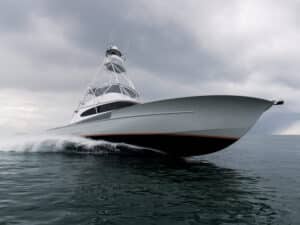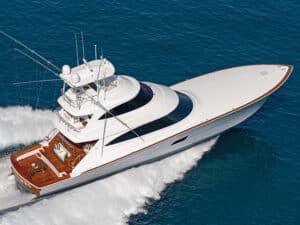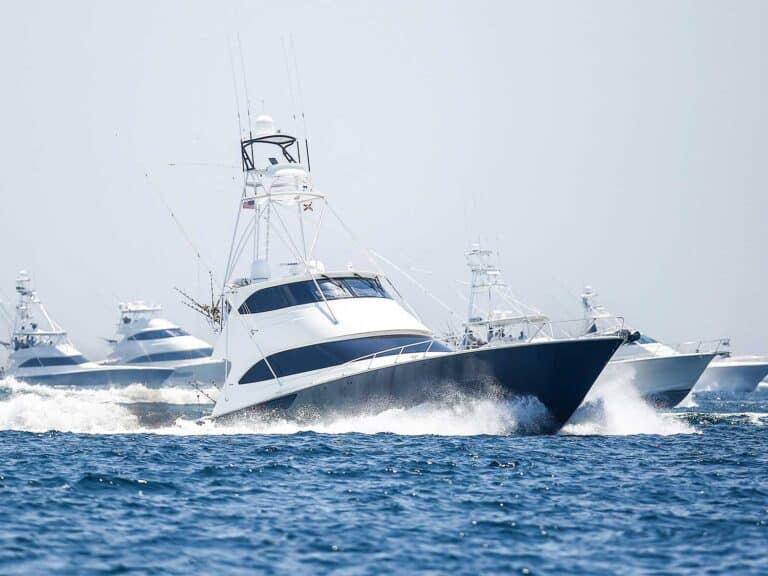
0310br_american368
It turned out to be an unfortunate choice of time to test this boat. The week had seen record low temperatures throughout Florida, including snow, believe it or not. The morning we tested the boat, the north wind blew at about 20 knots with higher gusts, and temperatures stretched all the way to the high 30s. The inlet at Stuart, Florida – famous for its roughness in certain wind directions – saw four-foot, close-together seas with taller but longer swells offshore.
Performance
The only way I can imagine the twin MTU V-16s rated at 2,400 hp each being much larger is if each horse actually existed in Clydesdale reality.
Pushing the controls forward results in the 68 providing a very subtle sensation of getting on plane rather than an exaggerated bow rise.
In the calm of the Intracoastal, we topped out at 41.8 knots (2,315 rpm), burning 180.8 gph. A reasonable cruising speed of 30 knots at 1,800 rpm used just more than 100 gph. ACY president Dominick LaCombe says that the company plans to fine-tune the wheels before the final sea trials, and, therefore, you should see more speed.
The ACY 68 sports a brand-new steering mechanism, one that I’ve never seen before. Called a Jastran electro-hydraulic steering system, it comes with two display gauges (both analog), one telling you to what angle you’ve turned the rudders and the other providing the actual position of the rudder at that moment. Coupled with American Custom Yachts’ own swept-back rudder design, the 68 turns like a dream, leaning into turns in stately fashion yet carving a remarkably tight arc.
Maneuvering on a fish, the 68 spins and backs to perfection – it can do anything you would ever want to do with a hot fish on the corner.
The ACY 68 runs smoothly and dryly on all points of sea and at all speeds. And I’d expect nothing less from LaCombe and the Chouest family, foremost builders of the world’s most rugged support vessels for the offshore oil industry.
Interior
Admittedly, the interior was slightly less than complete since ACY wants the new owner to personalize the boat. However, American always chooses top-of-the-line appliances and soft goods, and it has already installed beautiful granite counters, a Wolf four-burner ceramic cooktop hidden under a granite cover and a Wolf microwave/convection oven. I hope the new owner loves to cook.
Interestingly, the boat hides under-counter refrigerators, but not the drawer type so common today. A hatch in the galley floor provides access down to the pump room at the forward end of the engine compartment.
American Custom Yachts also excels in two other areas besides performance: gorgeous cabinetry and innovative features. I found one such element in the companionway heading down to the living quarters. The unusual starboard-side companionway sports a large, lovely wooden bulkhead outboard. At the press of a hidden button, the wall drops out and down on rams, revealing substantial rod storage.
Under way, the living quarters remain remarkably quiet – in the master stateroom, the sound of water passing along the hall was louder than the running machinery.
Engine Room
Open the engine room hatch in the cockpit to find the FCI watermaker display and controls, circuit breakers, controls for waste tanks, baitwells and fuel transfer – all immediately and conveniently at hand.
The generator room lies behind the door at the base of the engine-room ladder, and the crash pumps are located right at the entrance and are, therefore, easily accessed in an emergency. The entire engine room shines with starkly clean finishes, and with easy access to everything and the isolated noisemaking equipment, this may just qualify as the best designed and engineered engine compartment I’ve ever seen.
Cockpit
On centerline in the cockpit is a large fish box with a stainless-steel liner that catches the 600 pounds of chipped ice produced by the Eskimo ice maker each day. An offset fighting chair mounts forward of the fish box, so you don’t have to worry about reaching the corners.
The flybridge ladder starts out vertical but then angles outboard to make the climb more secure. I particularly like the number and placement of handholds throughout the boat, especially on the way up to the flybridge.
Another well-executed feature places fittings for removable baitwells up under the covering boards. With the two livewells already built in, this brings the possible total to four.
The cockpit is incredibly clean, with most systems and features cleverly hidden.
Flybridge

From the helm, you can see the last third of the cockpit and the forward half of the foredeck. The foredeck sports a pronounced crown and a noticeable downward curve at the stem. Again, in keeping with the streamlined look, one electronics box drops down from overhead containing the MTU engine and VEI infrared camera displays. Another hatch hides the electric teaser reels.
One feature I particularly appreciate – the tower legs fit inside the flybridge rail. I love not having to climb out over the rail, hanging my butt over the cockpit or sea in rough weather. Thanks to Baush American, this is a much safer design.
The tower electronics include a compass, VHF, engine gauges and a repeater for the Simrad.
Design and Construction
The laminate schedule from the outside in calls for fiberglass, Kevlar, mahogany plywood and Kevlar again, all tied together with epoxy resins. Every painted surface gets coated with Imron.
This ACY 68 will certainly turn heads but not for the same reasons that its sister ships do. This boat shines due in large part to its simplicity. Creating something that excels so completely on the performance and fishing end, and yet keeps the traditional look of true sport-fisher, well, that takes real talent!
Specifications
LOA……68’6″
Beam……19’6″
Deadrise……12 degrees
Draft……5’4″
Weight……92,000 pounds (full load)
Fuel……2,600 gallons
Water……230 gallons
Power……T 2,400 hp MTU diesels
Price……On request
American Custom Yachts / Stuart, Florida / 772-221-9100 / www.americancustomyachts.com







